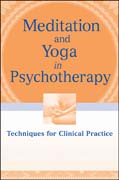
Meditation and yoga in psychotherapy: techniques for clinical practice
Simpkins, Annellen M.
Simpkins, C. Alexander
Filled with vivid case examples and writings from renowned yoga masters, Meditation and Yoga in Psychotherapy encourages a therapeutic process in which clients move their attention from outside concerns to inner mindfulness. With a range of techniques that embrace the diversity and uniqueness of clients, this book offers methods to creatively individualize techniques for a wide variety of presenting problems. INDICE: "Part I: Efficacy and Neuroscience Research. Chapter 1: Efficacy. Efficacy Studies Overview. Efficacy Studies for Specific Problems. Conclusion.Chapter 2: Yoga and the Brain. The Relationship Between Mind and Brain Overview of How Yoga Affects the Brain The NeuroAnatomy of Yoga From Mind to Brain; Neuroplasticity and Neurogenisis. Conclusion: Using More of the Brain. Part II: What is Yoga? Chapter 3: Traditions. Tracing Yogas Roots in Ancient Texts. Different Forms of Yoga. Introduction to the West through Great Teachers. Conclusion. Chapter 4: Philosophy. From Samkhya to Yoga: Integration of Mind and Matter. The Eight Limbs of Yoga. Integration. Conclusion. Chapter 5: Practices. Integrating Yamas and Niyamas as a Therapeutic Tool Asana Postures. Pranayama Breathing Meditation Conclusion. Part III: Applications. Chapter 6: OvercomingStress with the Eight Limbs of Therapy. Background and Theory. Taking Yoga from Theory to Practice. Using the Yamas and Niyamas. Pratyahara: Withdrawing. Dhranna: Narrowing the Focus. Dhyana: Opening the Focus. Fostering Relaxation. Conclusion. Chapter 7: Transcending Anxiety. The Anxious Mind, Brain, Body, and Spirit. Categories of Anxiety. Yoga Treatments. Overcoming Anxiety Actively.Dynamic Work on the Anxious Mind-Body-Brain System. Working with Panic Disorder. Treatments for PTSD. Treatment for OCD: Trading Rituals. Conclusion. Chapter 8: Freedom from Depression's Grip. Theories of Depression: Neuro-Chemical, Cognitive, Social, and Their Integration. Working with Depression Integratively. Altering the Neuro-Chemical Balance. Fostering Cognitive Change. Improving Social Interactions. Conclusion. Chapter 9: Addiction: Five Steps to Lasting Release. Definitions. Neurobiology of Addiction. A Five-Step Method for Treating Addiction Conclusion. Chapter 10: Adapting Yoga for Children. ADHD: Discovering Steady Attention. Overcoming Anxiety and Stress. Aggressive Behavior. Special Variations for Meditation with Children. Learning and Memory: Using Wisdomto Gain Knowledge. Conclusion. Chapter 11: Healthy Aging. The Aging Mind, Brain, and Body. Uncovering the Value of Aging. Enhancing Vitality, Flexibility, and Strength: Chair Sitting Yoga. Working with Memory. Pain Control. Conclusion. Chapter 12: Both Clients and Therapists Living for the Soul. What is the Soul? Soul of the Client: Fostering the Best. Drawing Upon the Soul of the Therapist. Attainment of Freedom. Bibliography. Appendix I Fundamental Stretching. Appendix II Fundamental Neuroscience. "
- ISBN: 978-0-470-56241-3
- Editorial: John Wiley & Sons
- Encuadernacion: Rústica
- Páginas: 320
- Fecha Publicación: 08/12/2010
- Nº Volúmenes: 1
- Idioma: Inglés
